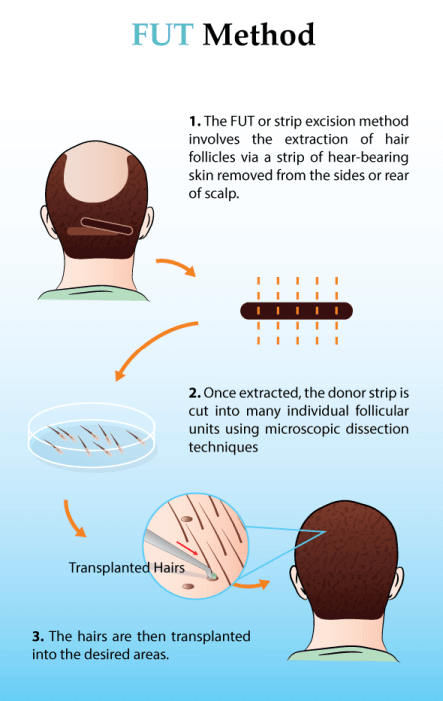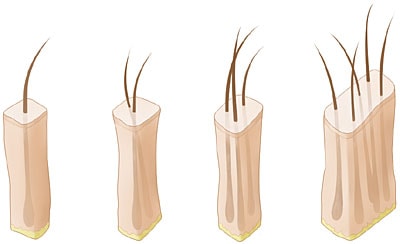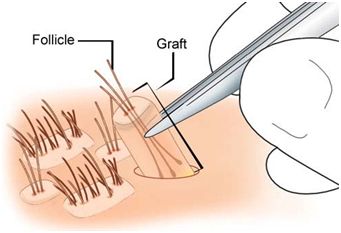
Follicular Unit Transplantation (FUT) is a medical procedure where hair is transplanted from the permanent zone, the region in the back and sides of the scalp where hair is more impervious to thinning, to the bald or balding areas of the scalp. This is accomplished using naturally occurring groups of 1 to 4 hairs, called follicular units. After the patient’s scalp is anesthetized, the doctor removes a strip of tissue from the donor area, an area within the permanent zone, and, once extracted, the donor strip is separated into many individual follicular units using microscopic dissection techniques. As these follicular unit grafts are being prepared, the doctor makes tiny holes in the scalp, called recipient sites, where the grafts are placed.
The arrangement and positioning of these follicular unit grafts determines the aesthetic qualities of a hair transplant, and so this arrangement must be decided on a case-by-case basis, depending on the patient’s history of hair loss and likelihood of future hair loss. Read more about hair loss in men and hair loss in women. Since follicular unit transplants imitates the way hair grows in nature, the results, in expert hands, will look totally normal and be indistinguishable from one’s original hair. See some of these outcomes in our Testimonials section.
New Hair Growth
New hair growth starts about 3-4 months after the procedure. By 6 months, around half of the newly transplanted hair starts to grow, and by 9 months, almost 80% of the hair grafts will be growing. By 12-18 months, the regions where hair loss once occurred will be filled in with thicker and fuller hair, leaving patients excited about their results.

For years it was assumed that scalp hair grew out as individual strands, but scalp hair actually grows in small groups of 1-4 hairs each. These groups are called “follicular units.” Since the follicular unit is a distinct anatomic and physiologic entity, preserving it intact during the graft dissection will maximize growth. Read more about hair growth and hair loss here.
The exclusive use of these naturally-occurring units in FUT ensures that each graft will be identical to the surrounding follicular units. Thus, when the transplanted follicular units grow hair after a transplant, the overall results of the transplant will appear natural.


One of the most critical parts of Follicular Unit Hair Transplantation is stereo-microscopic dissection. This permits follicular units to be isolated from the donor strip without being broken up or damaged.
Follicular units are relatively compact structures, but are surrounded by substantial amounts of non-hair bearing skin. This extra tissue can be removed without injuring the follicles, using stereo-microscopic dissection. These small, trimmed, follicular unit grafts can then be placed into tiny incisions in the patient's scalp; thereby minimizing damage to the scalp's connective tissue and blood supply.
During graft dissection, it is very important that the whole follicular unit is kept intact as this will maximize its growth. Intact follicular units will also give the most fullness to the hair restoration, as they contain the full, natural complement of 1-4 hairs.

In the terminology of hair transplantation, the recipient site is the place that hair is transplanted to correct hair loss. Recipient sites are the tiny slits or holes that the hair transplant doctor makes in the patient’s scalp, where the follicular unit grafts are placed during a hair transplant procedure.
The purpose of hair transplantation is to restore aesthetic balance to a person's appearance - a balance that is lost with balding of the scalp. The hair loss area can become the feature that draws attention away from the face and dominates overall facial appearance.
Primary aesthetic concerns that are addressed include:
The hairline: A recreated hairline should be placed at an aesthetically correct position on the frontal scalp, be natural in appearance, be proper to the patient's age, and be appropriate with the appearance of other original or restored hair on the scalp. The doctor will likewise consider how a recreated hairline will "age" as the patient ages. The hairline should remain appropriate to the patient's age over a period of time; a hairline that looks natural when the patient is 28 should continue to look natural when the patient is 48.
Natural appearance and ease of styling: "Natural appearance" is the key phrase describing hair transplantation today. The type of donor hair selected, graft placement, size of grafts and overall transplant technique are chosen to guarantee that transplanted hair is as "natural" in appearance as the original hair and is amenable to styling as appropriate to the patient's wishes.
The donor area is the region of the scalp (typically on the back and sides) where hair-bearing skin is removed during a surgical hair restoration procedure. For hair transplants to be successful, the hair in this area must be permanent and not influenced by the gene(s) responsible for male pattern hair loss (i.e. not subject to the effects of DHT). With minor exceptions, the donor site is the same for both male and female hair transplantation.
Minimizing the scar from the donor incision is a critical part of a successful hair transplant procedure. A fine donor scar allows a person to keep his/her hair relatively short after the hair restoration (if one wants to do so) and increases the amount of hair that can be harvested (removed) in later hair transplant procedures.
Choosing how many follicular unit grafts will be transplanted in a hair transplant is an important aspect of planning and designing a hair transplant for the maximum possible aesthetic impact. The doctor will provide general guidelines for the number of follicular unit grafts needed in a patient’s first hair transplant procedure and for subsequent procedures, if more than one session is indicated.
FUT was a major development over the, now outdated, “mini-micrografting” hair transplant procedures that preceded it. In mini-micrografting, the graft sizes were arbitrarily determined by the hair restoration doctor, who would cut the donor tissue into different size pieces. These larger grafts, commonly known as “hair plugs,” might have contained up to 12 or more hairs, were bulky, and could produce a tufted appearance. They could also cause dimpling of the underlying skin.
The significant advance brought by Follicular Unit Transplantation is that the use of special stereo-microscopes allows doctors to carefully dissect the hair grafts. This helps to preserve the integrity of the follicular units and allows the doctor to keep all of the growth elements of the hair follicle unharmed. The survival of the grafts is maximized and, as a result, both the hair transplant and the underlying skin will look completely normal when the transplant matures. With FUT, thousands of grafts can safely be transplanted in one session, allowing the patient to complete the hair restoration as quickly as possible.
Follicular Unit Extraction uses similar methodology, with the main exception being that the follicular unit grafts are extracted directly from the donor area.
Follicular Unit Extraction (FUE) and Follicular Unit Transplantation (FUT) are often compared as if they are two completely different, even competing, hair transplant procedures. Despite this common misconception, the difference between FUE and FUT is the way by which follicular units are removed from the donor region in the back and sides of the scalp. The rest of the hair transplant procedure is basically the same, and the results will appear similar.
However, the harvesting method does have important implications for the hair restoration procedure as it will affect the total number of high quality grafts that can be harvested from the donor region and therefore, the fullness achieved from the hair transplant. In general, the harvesting method of FUT via strip is superior to that of FUE for two main reasons. The first reason is that the FUT procedure allows the doctor to produce the highest quality grafts by isolating the follicle units with minimal trauma (this disadvantage is minimized with Robotic FUE). The second is that FUT enables the doctor to best utilize the most permanent part of the donor region.
While the FUT (“strip method”) procedure produces wonderful results, the FUE procedure is sometimes preferred by patients because it is minimally invasive as it does not involve a scalpel or stitches, nor does it leave any noticeable linear scars at the back of the scalp.
Because the differences between FUE and FUT are significant, the pros and cons of FUE hair transplant surgery should be considered when deciding which procedure is best for you.

If you are experiencing thinning hair or balding and are living with stress over the loss of your hair, we encourage you to contact us now. You can find the answers to the most frequently asked questions here. Our Korea-based doctors will give you a thorough consultation and a detailed treatment plan, and provide you with an effective, lasting solution.

Please send us your email address, and one of our representatives will personally contact you as soon as possible.
Your email address will never be sold or spammed.